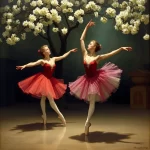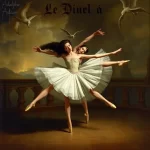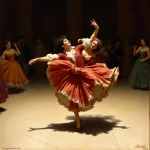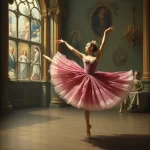Ballet: Le Réveil de Flore (Riccardo Drigo, 1894)

Introduction
Ballet, an art form that combines music, dance, and storytelling, has produced numerous masterpieces over the centuries. One such gem is “Le Réveil de Flore,” a one-act ballet composed by Riccardo Drigo and choreographed by Marius Petipa. Premiered on May 9, 1894, at the Imperial Mariinsky Theatre in St. Petersburg, this ballet is a delightful representation of the classical ballet tradition. The plot revolves around the awakening of Flora, the Roman goddess of flowers, and her interactions with other mythological characters, encapsulating themes of love, beauty, and nature.
Historical Background
Creation and Development
“Le Réveil de Flore” was created during a period of significant artistic and cultural development in Russia. The late 19th century was a golden age for ballet, with the Imperial Russian Ballet at the forefront of innovation and excellence. The ballet was inspired by classical mythology and the pastoral themes popular in the arts at the time. The collaboration between Marius Petipa, the renowned choreographer, and Riccardo Drigo, the esteemed composer, was instrumental in bringing this ballet to life. Petipa’s choreography was known for its intricate patterns and expressive movements, while Drigo’s music provided a rich, melodic backdrop that enhanced the narrative.
Premiere and Reception
The premiere of “Le Réveil de Flore” took place on May 9, 1894, at the Imperial Mariinsky Theatre in St. Petersburg. The ballet was well-received by both critics and audiences, who praised its enchanting music, elegant choreography, and the performances of the dancers. Notable early performances included those by the prima ballerina Pierina Legnani, who played Flora, and Pavel Gerdt, who portrayed Apollo. The ballet was revived several times in the early 20th century, maintaining its popularity and influence.
Synopsis of the Ballet
“Le Réveil de Flore” is a one-act ballet that unfolds in a single, continuous narrative. The story is set in a beautiful garden where Flora, the goddess of flowers, is asleep. She is awakened by the god of love, Eros, who is accompanied by Zephyr, the gentle wind. Together, they celebrate the arrival of spring and the renewal of nature.
Key Moments
- Flora’s Awakening: The ballet opens with Flora asleep in a garden. Eros and Zephyr arrive and gently awaken her, symbolizing the arrival of spring.
- Dance of the Flowers: Flora and her attendants perform a series of dances celebrating the beauty and diversity of flowers.
- Pas de Deux: A romantic duet between Flora and Apollo, the god of the sun, highlighting their love and the harmony of nature.
- Finale: The ballet concludes with a grand celebration involving all the characters, symbolizing the joy and renewal brought by spring.
Musical Composition
Composer’s Role
Riccardo Drigo, an Italian composer and conductor, played a crucial role in the creation of “Le Réveil de Flore.” Drigo was known for his ability to compose music that perfectly complemented the choreography and enhanced the emotional impact of the ballet. His score for “Le Réveil de Flore” is characterized by its lyrical melodies, rich harmonies, and vibrant orchestration. Notable pieces within the score include the “Dance of the Flowers” and the “Pas de Deux” between Flora and Apollo.
Musical Themes and Motifs
The music of “Le Réveil de Flore” features several recurring themes and motifs that enhance the narrative and emotional depth of the ballet. The use of leitmotifs, or recurring musical phrases associated with specific characters or ideas, helps to unify the score and create a cohesive musical experience. For example, Flora’s theme is delicate and lyrical, reflecting her gentle and nurturing nature, while Apollo’s theme is bold and majestic, symbolizing his power and radiance.
Famous Recordings and Performances
Over the years, “Le Réveil de Flore” has been performed and recorded by numerous prestigious ballet companies and orchestras. Notable recordings include those by the Mariinsky Theatre Orchestra and the Bolshoi Theatre Orchestra, both of which capture the beauty and intricacy of Drigo’s score. These recordings have helped to preserve the ballet’s musical legacy and introduce it to new audiences.
Choreography and Dance
Choreographer’s Vision
Marius Petipa, the choreographer of “Le Réveil de Flore,” was a master of classical ballet and known for his innovative and expressive choreography. Petipa’s vision for the ballet was to create a work that celebrated the beauty of nature and the joy of spring. His choreography is characterized by its intricate patterns, graceful movements, and expressive gestures, all of which contribute to the ballet’s enchanting atmosphere.
Signature Dance Numbers
“Le Réveil de Flore” features several signature dance numbers that showcase Petipa’s choreographic brilliance. The “Dance of the Flowers” is a highlight of the ballet, featuring a series of elegant and intricate dances performed by Flora and her attendants. The “Pas de Deux” between Flora and Apollo is another standout moment, characterized by its romantic and expressive choreography. These dance numbers not only highlight the technical skill of the dancers but also enhance the narrative and emotional impact of the ballet.
Notable Interpretations
Over the years, “Le Réveil de Flore” has been interpreted and adapted by various ballet companies and choreographers. Each production brings its own unique vision and style to the ballet, while staying true to Petipa’s original choreography. Notable interpretations include those by the Mariinsky Ballet, the Bolshoi Ballet, and the Royal Ballet, all of which have contributed to the ballet’s enduring legacy.
Characters and Roles
Main Characters
- Flora: The Roman goddess of flowers, Flora is the central character of the ballet. She is gentle, nurturing, and embodies the beauty and renewal of nature.
- Apollo: The god of the sun, Apollo is Flora’s love interest. He is powerful, radiant, and symbolizes the harmony of nature.
- Eros: The god of love, Eros plays a key role in awakening Flora and bringing about the celebration of spring.
- Zephyr: The gentle wind, Zephyr assists Eros in awakening Flora and is associated with the arrival of spring.
Supporting Characters
- Attendants of Flora: A group of dancers who represent various flowers and perform elegant dances celebrating the beauty of nature.
- Other Mythological Characters: Various gods and goddesses who join in the celebration of spring and contribute to the ballet’s enchanting atmosphere.
Famous Dancers
Over the years, many renowned dancers have portrayed the roles in “Le Réveil de Flore.” Notable performers include Pierina Legnani as Flora, Pavel Gerdt as Apollo, and Enrico Cecchetti as Eros. These dancers brought their own unique interpretations to the roles, contributing to the ballet’s enduring legacy.
Cultural and Artistic Impact
Influence on Ballet and Dance
“Le Réveil de Flore” has had a significant influence on the world of ballet and dance. Its innovative choreography, enchanting music, and timeless themes have inspired countless choreographers, composers, and dancers. The ballet’s emphasis on the beauty of nature and the joy of spring has also influenced other works in the classical ballet repertoire.
Cultural Significance
The ballet’s themes of love, beauty, and renewal have resonated with audiences for over a century, making it a beloved work in the classical ballet canon. “Le Réveil de Flore” has also been referenced in literature, film, and other media, further cementing its place in popular culture.
Legacy and Revivals
“Le Réveil de Flore” continues to be performed and celebrated today, with major revivals and reinterpretations by prestigious ballet companies around the world. These modern adaptations often bring new perspectives and innovations to the ballet, while staying true to its original spirit. The ballet’s enduring popularity is a testament to its timeless appeal and artistic excellence.
Iconic Productions
Historic Productions
Some of the most famous historical productions of “Le Réveil de Flore” include those by the Imperial Mariinsky Theatre and the Bolshoi Theatre. These productions featured renowned dancers, directors, and set designers who brought the ballet to life with their artistic vision and skill.
Contemporary Productions
Recent productions of “Le Réveil de Flore” have continued to captivate audiences with their innovative interpretations and high-quality performances. Companies such as the Mariinsky Ballet, the Bolshoi Ballet, and the Royal Ballet have all staged successful revivals of the ballet, showcasing its enduring appeal and relevance.
Production Design
The set, costume, and lighting design in various productions of “Le Réveil de Flore” have played a crucial role in creating the ballet’s enchanting atmosphere. From the lush garden settings to the elaborate costumes representing various flowers and mythological characters, the production design enhances the visual and emotional impact of the ballet.
Critical Reception and Reviews
Initial Critical Response
At the time of its premiere, “Le Réveil de Flore” received positive reviews from critics, who praised its enchanting music, elegant choreography, and the performances of the dancers. The ballet was seen as a delightful representation of the classical ballet tradition and a celebration of the beauty of nature.
Modern Reviews
Contemporary critics and audiences continue to appreciate “Le Réveil de Flore” for its timeless themes, beautiful music, and expressive choreography. The ballet remains relevant and popular today, with many praising its artistic excellence and enduring appeal.
Fun Facts and Trivia
Behind-the-Scenes Stories
One interesting anecdote from the production of “Le Réveil de Flore” involves the prima ballerina Pierina Legnani, who played Flora. Legnani was known for her incredible technical skill and famously performed 32 fouettés en tournant in the ballet, a feat that became a hallmark of her career.
Notable Performers
In addition to Pierina Legnani, other famous dancers associated with “Le Réveil de Flore” include Pavel Gerdt as Apollo and Enrico Cecchetti as Eros. These dancers brought their own unique interpretations to the roles, contributing to the ballet’s enduring legacy.
Trivia
- “Le Réveil de Flore” was one of the first ballets to feature a “Pas de Deux” as a central element of the choreography.
- The ballet’s score by Riccardo Drigo is considered one of his finest works and has been praised for its lyrical melodies and rich harmonies.
- The ballet’s themes of love, beauty, and renewal have made it a popular choice for springtime performances.
Conclusion
Summary of the Ballet’s Importance
“Le Réveil de Flore” is a significant work in the world of ballet, celebrated for its enchanting music, elegant choreography, and timeless themes. The collaboration between Marius Petipa and Riccardo Drigo resulted in a masterpiece that continues to captivate audiences over a century after its premiere.
Final Thoughts
Reflecting on “Le Réveil de Flore,” it is clear that the ballet’s enduring appeal lies in its celebration of the beauty of nature and the joy of spring. Its artistic excellence and timeless themes make it a beloved work in the classical ballet repertoire. For those who have not yet experienced this enchanting ballet, watching a performance or listening to the score is highly recommended.
FAQ
What is the central theme of this ballet?
The central theme of “Le Réveil de Flore” is the celebration of the beauty of nature and the joy of spring, symbolized by the awakening of Flora, the goddess of flowers.
Who are the main characters in this ballet?
The main characters in “Le Réveil de Flore” are Flora, the goddess of flowers; Apollo, the god of the sun; Eros, the god of love; and Zephyr, the gentle wind.
What is the most famous dance number in this ballet?
The most famous dance number in “Le Réveil de Flore” is the “Pas de Deux” between Flora and Apollo, which showcases their love and the harmony of nature.
How long does a typical performance of this ballet last?
A typical performance of “Le Réveil de Flore” lasts approximately 45 minutes to one hour, as it is a one-act ballet.
Are there any modern adaptations of this ballet?
Yes, there have been several modern adaptations and revivals of “Le Réveil de Flore” by prestigious ballet companies such as the Mariinsky Ballet, the Bolshoi Ballet, and the Royal Ballet.
Why is this ballet considered important in the history of dance?
“Le Réveil de Flore” is considered important in the history of dance due to its innovative choreography, enchanting music, and timeless themes. It has had a significant influence on the world of ballet and continues to be celebrated and performed today.





